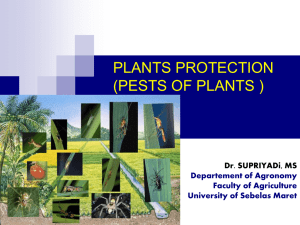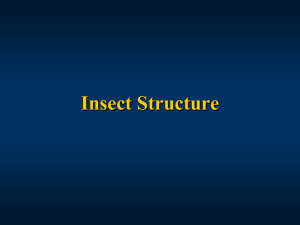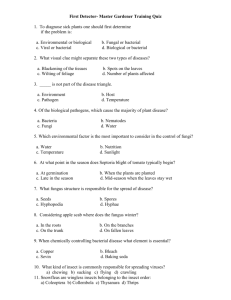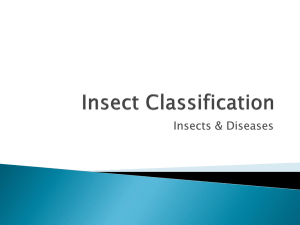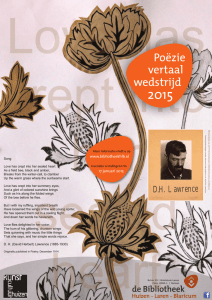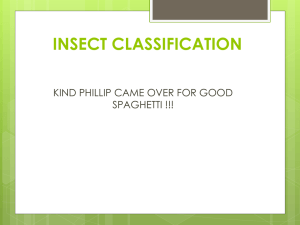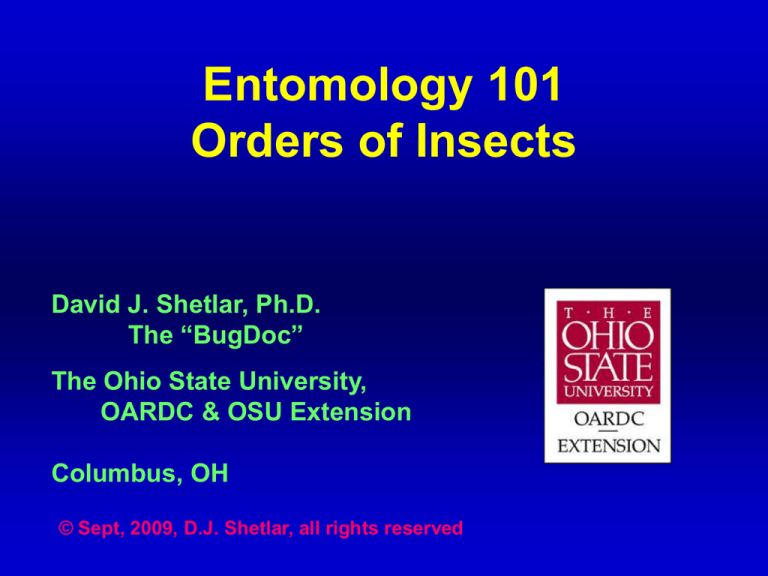
Entomology 101
Orders of Insects
David J. Shetlar, Ph.D.
The “BugDoc”
The Ohio State University,
OARDC & OSU Extension
Columbus, OH
© Sept, 2009, D.J. Shetlar, all rights reserved
Class Hexapoda
(the insects)
•
•
•
•
•
Three tagmata – head, thorax,
abdomen
Thorax with three pairs of legs;
normally two pairs of wings in adult
stage
Head with one pair of antennae
Respiration by trachea
Terrestrial & fresh water inhabitants
Class Hexapoda
(all have one pair of antennae, a head, thorax &
abdominal regions, three pair of legs, adults usually
have wings, use trachea)
Life Cycle Groups
•
•
Simple Metamorphosis (=incomplete) egg, nymph, adult stages
Complete Metamorphosis - egg, larva,
pupa, adult stages
Incomplete Metamorphosis Example
(hairy chinch bug)
egg
Egg
Stage
1st
instar
2nd
instar
3rd
instar
Nymphal
Stage
4th
instar
5th
instar
adult
Adult
Stage
Incomplete Metamorphosis Example
(hairy chinch bug)
egg
1st
instar
Egg
Stage
2nd
instar
3rd
instar
4th
instar
Nymphal
Stage
5th
instar
normal wing
adult
short wing
adult
Adult
Stage
Complete Metamorphosis Example
(May/June beetle)
egg
Egg
Stage
1st
instar
2nd
instar
Larval
Stage
3rd
instar
pupa
Pupal
Stage
adult
Adult
Stage
Complete Metamorphosis Example
(northern masked chafer)
egg
Egg
Stage
1st
instar
2nd
instar
Larval
Stage
3rd
instar
pupa
Pupal
Stage
adult
Adult
Stage
Hexapod Orders
Entognathous Hexapods –
(simple metamorphosis cont’d)
Order Protura
Order Mantodea
Order Collembola
Order Blattodea
Order Diplura
Order Hemiptera
Ectognathous apterygote Hexapods –
Order Thysanoptera
Order Microcoryphia
Order Psocoptera
Order Thysanura
Order Phthiraptera
Pterygote Hexapods –
(simple metamorphosis)
(complete metamorphosis)
Order Coleoptera
Order Ephemeroptera
Order Neuroptera
Order Odonata
Order Hymenoptera
Order Orthoptera
Order Trichoptera
Order Phasmatodea
Order Lepidoptera
Order Dermaptera
Order Siphonaptera
Order Plecoptera
Order Diptera
Order Isoptera
Orders of Insects
(no metamorphosis)
•
•
•
•
Some consider these groups
insect-like and place in different
class or subclass.
Adults do not have wings and
may molt after becoming mature
Thysanura - silverfish, firebrats
Collembola - springtails
Order Thysanura (=bristle tail)
silverfish & firebrats
• Look like they have 3 tails –
• 2 cerci
• 1 median filament
•
•
•
•
•
Wingless (originally)
Most are covered with scales
Chewing mouthparts
Gradual (no) metamorphosis
Feed on organic matter & starches
Thysanura (=bristletail)
(silverfish, firebrats; 0.4K spp.)
[no wings as adults, usually 3 caudal appendages (two
cerci and median filament); adults may continue to molt]
Silverfish
Fourlined silverfish
Order Collembola (=glue wedge)
springtails
•
•
•
•
•
•
Wingless (primitively)
Chewing mouthparts
Gradual (no) metamorphosis
Adults continue to molt
Feed on plants, bacteria, & fungi
Important as decomposers and
bioindicators
Order Collembola (=glue wedge)
springtails
• Tiny, most < 3 mm
• Collophore
•
•
Water regulatory structure
Underside 1st abdominal segment
•
•
•
Forked jumping appendage
Underside 4th abdominal segment
Held bent under body
• Furcula
• Escape by catapulting
Collembola (=glue wedge)
(springtails; >6K spp.)
[no wings as adults, caudal appendage designed for jumping
(furcula & colliphore); adults may molt]
Springtail with furcula
exposed.
Globular springtail, upper
and lower views, spots on
head are not eyes! Eyes
are lower on head.
Springtails often have long hairs
and multicolored scales.
Aquatic springtails have waxy
hairs that allow them to float on
the water surface. These
springtails feed on algae.
Orders of Insects
(simple metamorphosis)
•
•
•
•
•
•
Ephemeroptera - mayflies, shadflies
Odonata - dragonflies, damselflies
Orthoptera - grasshoppers, crickets,
katydids
Dermaptera – earwigs
Plecoptera - stoneflies
Isoptera - termites
Order Ephemeroptera
(=short lived, on the wing)
Mayflies
• Nymphs (naiads) aquatic
• Wings triangular, held over back
• Front wings large, usually with many veins
• Hind wings small or absent
• Adults with 2 or 3 long caudal
•
•
filaments
Last instar nymph flies from water
(subimago)
Adults live for hours to a few days.
Ephemeroptera (=short lived on the wing)
(Mayflies, shadflies, Canadian soldiers; 2K spp.)
[front wings large, triangular, held over body at rest;
hind wings small or absent; aquatic nymphs with
abdominal gills; caudal appendages (2 or 3) long;
chewing mouthparts often non-functional in adult]
Mayfly adults, one two-tailed and
one three-tailed.
Mayfly naiad.
Hexagenia, large Mayfly, subimago
(last instar nymph). Note cloudy
wings and short tails.
Hexagenia adult. Note clear
wings and long tails.
Order Odonata
(=toothed – large mandibles)
Dragonflies and Damselflies
• Front & Hind Wings narrow
• Many veins and cross veins
• Dragonflies hold wings out at rest
• Damselflies hold wings over back
• Nymphs (naiads) aquatic
•
•
•
Naiads predatory, have grasping
mouthparts
Dragonfly naiads have rectal gills
Damselflies have leaflike gills on abdomen
tip.
• Adults are beneficial predators.
Odonata (=toothed)
(dragonflies and damselflies; 5K spp.)
[front and hind wings narrow with many cross veins,
membranous; aquatic nymphs (naiads) predatory with
caudal or rectal gills; antennae bristlelike, no abdominal
cerci; chewing mouthparts]
Damselfly details
Order Orthoptera (=straight wing)
grasshoppers & crickets
• Two pairs wings
• Forewings leathery & narrow; protect
• Hindwings membranous, fan-folded
• Some are wingless (cave crickets)
• Most have hind legs enlarged for jumping
• Females have prominent ovipositor
• Produce songs by rubbing wing bases
together or rubbing the wings on their legs
Order Orthoptera (straight wing)
grasshoppers & crickets
•
•
•
•
•
Chewing mouthparts
Gradual metamorphosis
Antennae short or long
Most feed on plants
Some feed on organic matter,
stored products; few predatory
Orthoptera (=straight wing)
(grasshoppers, crickets, Katydids;
>20K spp.)
[front wings leathery, hind wings folded like a fan, chewing
mouthparts, two cerci - usually short]
Mating pair of grasshoppers
Female cone-nose grasshopper
Black field cricket
Order Dermaptera (=skin wing)
earwigs
• Chewing mouthparts
• Gradual metamorphosis
• Omnivorous
• Mostly scavengers
• Occasional pests of plants
• Nuisance pest in homes
Order Dermaptera (=skin wing)
earwigs
• Cerci shaped like forceps, pinchers
•
Defense, prey capture, mating
• Elongate, flattened
• Two pairs of wings
• Forewings usually short, hard
• Hindwings membranous, folded
• Few species are wingless
Dermaptera (=skin wing)
(earwigs; 1.8K spp.)
[front wings short, leathery; hind wings double folded;
abdominal cerci forceps-like; chewing mouthparts]
Seashore earwig adult
European earwig with eggs
Order Plecoptera (=folded wing)
Stoneflies
• Nymphs Aquatic (naiads)
•
•
•
Abdominal &/or thoracic gills
Predators & herbivores
Flat with obvious cerci
• Chewing Mouthparts
• Adults with
•
•
•
Front wing narrow, bladelike
Hind wing broad, flolded
Medium to long cerci
• Good indicators of water quality
Plecoptera (=folded wing)
(stoneflies; 2K spp.)
[front wings narrow; hind wings folded fanlike; aquatic
nymphs (naiads) with abdominal gills; abdominal cerci
straight, moderately long; chewing mouthparts]
Giant Stonefly Adult
Order Isoptera (equal wing)
termites
• Social
• Reproductives (queens & kings)
• Four wings of equal size
• Wings twice the length of the body
• Wings lack cross-veins
• Workers & soldiers
• Lack wings
• Body white
• Distinguish from ants:
• Lack of elbowed antennae
• No constriction between abdomen & thorax
Order Isoptera (=equal wing)
termites
• Chewing mouthparts
• Gradual metamorphosis
• Feed on wood and plant materials
• Protozoans digest cellulose
• Significant structural pest
• Build distinctive nests
Isoptera (equal wing)
(termites; >2.3K spp.)
[social insects, winged reproductives with both wings same
size and membranous; straight or curved antennae consists
of beadlike segments; abdomen broadly joined to thorax;
one to two-segmented cerci; chewing mouthparts]
Subterranean termite queen, king, workers and soldier
Nasutiform termite nest in tree.
Nasutiform soldiers
protecting opened nest.
Orders of Insects
(incomplete metamorphosis cont’d)
•
•
•
•
•
•
Mantoidea – mantids
Blattodea – cockroaches
Hemiptera - true bugs & bug-like
insects
Thysanoptera - thrips
Psocoptera - barklice, booklice
Phthiraptera - biting & sucking lice
Order Mantodea (=soothsayer)
mantids / praying mantid
•
•
•
•
•
Large (50-100 mm)
Forelegs modified for grasping prey
Predatory
Chewing mouthparts
Gradual metamorphosis
Mantodea (=soothsayer)
(mantids, praying mantis; ~1.8K spp.)
[front legs raptorial (modified for grasping), prothroax
elongated, chewing mouthparts, two short cerci]
Order Blattodea (=L. cockroach)
cockroaches
•
•
•
•
•
•
•
•
Flattened body
Long slender antennae
Wings thickened, leathery
Wings reduced in some species
Legs modified for running
Chewing mouthparts
Gradual metamorphosis
Feed on organic matter, stored
products, plants
Blattodea (L. cockroach)
(cockroaches; <4K spp.)
[body flattened and oval, front wings leathery, hind wings
folded like a fan, chewing mouthparts, two short cerci]
Order Hemiptera (=half wing)
true bugs & bug-like insects
• Formerly 2 separate orders;
•
•
recently combined
Suborder Heteroptera
Suborders Auchenorrhyncha &
Sternorrhyncha (former Homoptera)
Suborder Heteroptera
the true bugs
•
•
•
Piercing/sucking mouthparts
Prominent beak arises from front of head
Two pairs of wings on most
• Forewings: thickened front halves
• Hindwings: membranous
• Forewings lay flat, overlapping
•
Scutellum (▼-shaped)
Suborder Heteroptera
true bugs
•
•
•
Many have scent glands
Plant feeders, predators, blood feeders
Gradual metamorphosis
Hemiptera (s.o. Heteroptera)
(half wing) (true bugs; 23K spp.)
[front wings half leathery & half membranous; hind
wings membranous; usually long antennae; sucking
mouthparts arise from front of head]
Suborder Auchenorrhyncha
leafhoppers, cicadas
& Suborder Sternorrhyncha
aphids,whiteflies, scales, psyllids,
mealybugs
•
•
Piercing/sucking mouthparts
Beak arises from rear underside of head
Suborders Auchenorrhyncha &
Sternorrhyncha
•
Wings:
• Uniformly textured
• Some have 4 wings
• Some have 2 wings (in males of some
species)
• Some have no wings
• Wings often held roof-like over the
body
Suborders Auchenorrhyncha &
Sternorrhyncha
• Gradual metamorphosis
• All are plant feeders
• Many are vectors of plant disease
Hemiptera (s.o. Auchenorrhyncha)
(buglike insects: cicadas, leaf, plant & tree hoppers;
33K spp.)
[front wings same texture throughout, leathery or membranous
(wings often absent); long or bristlelike antennae; sucking
mouthparts arise from back of head or between front legs]
Hemiptera (s.o. Sternorrhyncha)
(buglike insects: psyllids, whiteflies, aphids,
mealybugs, & scales)
Order Thysanoptera (=fringe wing)
thrips (singular & plural!)
• Small (most <4 mm), elongate
• Chewing mouthparts
• Small conical beak
• Rasping mouthparts
• Most with 4 wings
•
•
•
Strap-like
Fringed with long bristles
Some species are wingless
Order Thysanoptera (=fringe wing)
thrips
•
•
•
Plant feeders or predators
•
Thrips: only plural form of word!
Flowers are favored
Gradual metamorphosis but more
intermediate: egg, larva, prepupa, pupa,
adult
Thysanoptera (=fringe wing)
(thrips; 4.5K spp.)
[small; front and hind wings bladelike with hair fringe,
often absent; mouthparts modified rasping sucking;
antennae short]
Order Psocoptera (=rub wings)
psocids, booklice, barklice
• Small, soft-bodied
• Front of head bulging
• Wings present or absent
• Reduced veins when present
• Often reduced (brachypterous)
• Chewing mouthparts
•
•
Eat molds & mildews
Barklice feed on lichens
Psocoptera (=rub small wing)
(psocids, booklice, barklice; >3K spp.)
[front wings with reduced venation; hind wings
reduced or absent; wings often absent; distinctive
frontal bulge on head; long antennae; chewing
mouthparts; booklice are extremely flattened]
Order Phthiraptera
(=lice without wings)
• Formerly 2 separate orders
• Suborder Mallophaga (wool eater):
chewing lice
• Suborder Anoplura (unarmed tail):
sucking lice
Order Phthiraptera
(=lice without wings),
Suborder Mallophaga (=wool eater)
chewing lice
•
•
•
•
•
•
Small, hard, dorso-ventrally flattened
Wingless
Chewing mouthparts
Head usually broadly rounded & wider than
prothorax
Gradual metamorphosis
Feed mostly on birds, some mammals
Phthiraptera (Mallophaga)
(lice without wings) (biting lice; 2.7K spp.)
[very flat, small; no wings; chewing mouthparts;
external parasites of birds and mammals]
Chicken biting louse
Biting louse adult (above) and
eggs (right) on goose feathers.
Order Phthiraptera
(=lice without wings),
Suborder Anoplura (=unarmed tail)
sucking lice
•
•
•
•
•
•
Small, hard, dorso-ventrally flattened
Wingless
Piercing/sucking mouthparts
Head narrower than prothorax
Suck blood of mammals
Gradual metamorphosis
Phthiraptera (Anoplura)
(sucking lice; 0.3K spp.)
[small, flattened; no wings; sucking mouthparts;
external parasites of mammals]
Human head louse
Human crab louse


